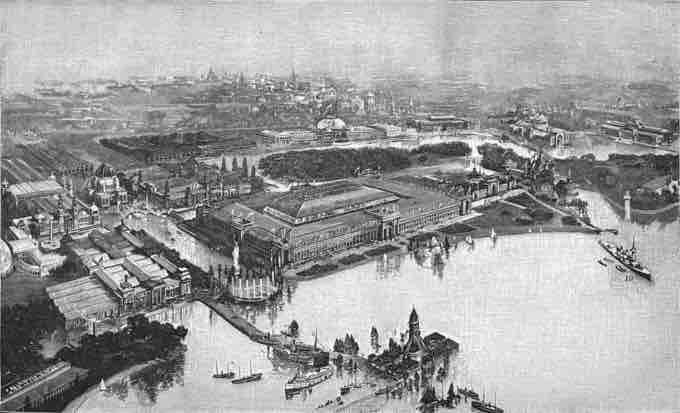The World's Columbian Exposition, also known as the "Chicago World's Fair," was held in 1893 to celebrate the 400th anniversary of Christopher Columbus's arrival in the New World in 1492. Chicago was selected over New York City; Washington, D.C.; and St. Louis to host the fair, which profoundly affected architecture, the arts, Chicago's self-image, and America's spirit of industrial optimism.
Daniel Burnham and Frederick Law Olmsted designed the exposition as a prototype of their vision of an ideal city. Built according to Beaux Arts and French neoclassical principles of architectural symmetry, balance, and splendor, the exposition covered more than 600 acres and included canals and lagoons, and nearly 200 temporary buildings in the neoclassical style. The fair's unprecedented scale and grandeur became a symbol of emergent American exceptionalism in much the way that the Great Exhibition became associated with the Victorian-era United Kingdom.
Most of the buildings of the fair were designed in the neoclassical architecture style. The area at the Court of Honor was known as "The White City." Facades were made not of stone, but of a mixture of plaster, cement, and jute fiber called "staff," which was painted white, giving the buildings their "gleam." Architecture critics derided the structures as "decorated sheds." The buildings were clad in white stucco, which, in comparison to the tenements of Chicago, seemed illuminated. It was also called "The White City" because of the extensive use of street lights, which made the boulevards and buildings usable at night.
The White City
The white buildings constructed for the exposition, in comparison to the Chicago tenements, appeared to gleam.
Dedication ceremonies for the fair were held on October 21, 1892. The fair ran for six months, from May 1 to October 30, 1893, and drew more than 27 million people. On October 9, 1893, the date designated as "Chicago Day," the fair set a record for outdoor event attendance, attracting 716,881 people. While the fair recognized the 400th anniversary of Europe's discovery of the New World, it also demonstrated that Chicago had risen from the ashes of the 1871 Great Chicago Fire.
Prominent civic, professional, and commercial leaders from around the United States helped to finance, coordinate, and manage the fair. These leaders included the shoe tycoon Charles H. Schwab and the railroad and manufacturing magnate John Whitfield Bunn, both of Chicago; the banking, insurance, and iron products magnate Milo Barnum Richardson, of Connecticut; and many other figures.
Attractions
The World's Columbian Exposition was the first world's fair with an area for amusements that was strictly separated from the exhibition halls. This area, developed by a young music promoter, Sol Bloom, concentrated on the Midway Plaisance and introduced the term "midway" to American English to describe the area of a carnival or fair where sideshows are located. The area included carnival rides, among them the original Ferris wheel, built by George Ferris. This wheel was 264 feet high and had 36 cars, each of which could accommodate 60 people.
The Original Ferris wheel
The wheel was 264 feet high and had 36 cars, each of which could accommodate 60 people.
The fair included life-size reproductions of Christopher Columbus's three ships, the Nina, Pinta, and Santa Maria. These were intended to celebrate the 400th anniversary of Columbus's discovery of the Americas. The ships, a joint project of the governments of Spain and the United States, were constructed in Spain and then sailed to America for the exposition. The ships were a very popular exhibit.
Eadweard Muybridge gave a series of lectures on the Science of Animal Locomotion in the Zoopraxographical Hall, built specially for that purpose on the Midway Plaisance. He used his zoopraxiscope to show his moving pictures to a paying public. The hall was the first commercial movie theater.
There was an Anthropology Building at the World's Fair. Nearby, "The Cliff Dwellers" featured a rock and timber structure that was painted to recreate Battle Rock Mountain in Colorado, a stylized recreation of an American Indian cliff dwelling with pottery, weapons, and other relics on display. Also featured were an Eskimo display and birch-bark wigwams of the Penobscot tribe.
The 1893 Parliament of the World’s Religions, which ran from September 11 to September 27, marked the first formal gathering of representatives of Eastern and Western spiritual traditions from around the world. According to Eric J. Sharpe, Tomoko Masuzawa, and other scholars, the event was considered radical at the time because it allowed non-Christian faiths to speak on their own behalf; it was not taken seriously by European scholars until the 1960s.

The World's Columbian Exposition from above
Print of an aerial view of the exposition.